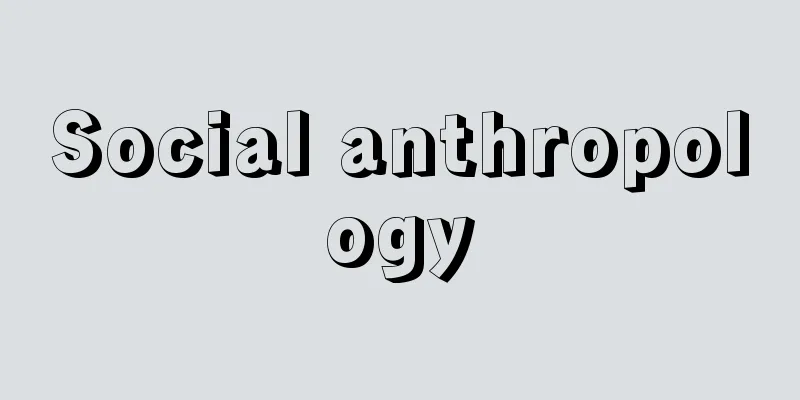Social anthropology

|
A branch of anthropology that conducts comparative studies of different societies based on intensive field research. Specifically, it analyzes the function, structure, and meaning of institutionalized systems of social behavior, such as family, kinship, political and economic organizations, religion, and rituals. Anthropology was born in the 19th century as an academic field to organize and systematize the rapid accumulation of information about non-Western societies that occurred after Western powers expanded throughout the world during the Age of Discovery. Based on this ethnographic tradition, in the 20th century in England, its empirical positivist tradition was combined with French sociology, particularly the theories of Durkheim, and anthropologists themselves conducted intensive surveys in the field, analyzed societies based on the data, and made remarkable progress in modeling their structures. In 1922, Malinowski and Radcliffe Brown published detailed monographs based on long-term research in the Trobriand Islands and the Andaman Islands, respectively. Both of these works were groundbreaking in that they emphasized the functional relationships between social institutions and revealed how social integration was maintained through detailed analysis of concrete facts. Therefore, this year marked the birth of social anthropology, a new field of anthropology that is completely different from evolutionism and cultural sphere theory, which speculate on the origins of institutions and the spread of culture based on unreliable data collected by others. Malinowski's functionalism is based on the premise that all social institutions have functional relationships with each other, for example, even things that at first glance appear to be relics of the previous century still perform some function as long as they exist. The social anthropological research that he modeled involves researchers living with the local people for a long period of time (at least one year), learning the local language and customs, and collecting data through participant observation. Radcliffe Brown's structuralism sought to extract structural forms from real social relations, compare the systems of different societies, and pursue laws. The disciples of these two scholars, who had acquired the research techniques and functional structuralist theory, produced a series of full-scale monographs and theoretical research based on them in various parts of the world from the 1930s to the 1950s, with Africa being their main field of study. In the 1950s, however, reflections began to emerge from within the field on the Radcliffe-Brown emphasis on the harmonious aspects of social integration, on the search for a model for social anthropology in natural science, and on the lack of interest in the process of historical change. Evans-Pritchard pointed out the similarities between the methods of social anthropology and history, and argued that social anthropology is closer to the humanities than to the natural sciences. L.M. Firth had emphasized individual choice from an early stage, and was one of the leading proponents of the theory of lineage origin, which became popular in the 1950s, mainly in Oceania. Gluckman, although within the limits of pre-established structuralism, showed an interest in the phenomenon of conflict and confrontation, which became the source of situation analysis and the theory of networks (webs of personal relationships). E. Leach opposed the view of society as a rigid structure, and in his monograph on the Kachin agricultural people of Myanmar (Burma), he proposed a dynamic model in which interactions based on individual interests temporarily bring about equilibrium and establish a system, but which is always subject to change. The second generation, which showed developments in these diverse directions, also had in common the fact that they produced monographs that clearly described the correspondence between concrete facts and theoretical analysis through meticulous descriptions of research material. The 1970s saw the retirement of the second generation, including Fortes, the most faithful successor of functional structuralism, and a new turning point. New trends include the influence of the marriage solidarity theory of the French scholar Lévi-Strauss, the study of symbolism, the increase in full-scale research on civilized society, which was already seen in Indian studies and the Chinese studies of Maurice Freedman (1920-1975), and the increase in researchers from non-Western countries. The most reliable and quickest way to get to the essence of social anthropology is to read one full-scale monograph rather than reading numerous overview books. [Michio Suenari] Trends in the 1980s and 1990sA major characteristic of social anthropology since the 1980s is the end of -ism. Until now, social anthropology has produced a succession of theoretical paradigms (exemplary achievements and frameworks of thought) that represent the current state of social anthropology and direct the course of the field, such as evolutionism, diffusionism, functionalism, functional structuralism, and structuralism. However, since the late 1970s, when the second generation of "giants" such as Evans-Pritchard, Gluckman, Firth, Fortes, and Leach retired one after another, social anthropology has come to emphasize the individuality of each society and culture and how to describe it, rather than aiming to construct a universal grand theory that would direct the course of the field. In this trend toward individualization, Needham has been working on a universal problem of humanity, namely, the pursuit of "human tendencies of thought," but so far there seems to be no movement to follow his lead. In the 1980s, the ideas of "from function to meaning" and "from explanation to description" came to be emphasized, and so-called "reflective anthropology," in which social anthropologists reflect on what they are doing, became popular. Until then, social anthropologists had focused on explaining the functions of social systems, rules, customs, etc. that exist in a given society based on information obtained from informants in the research field. However, in "reflective anthropology," it is considered that no system, rule, or custom has substance apart from the context (surrounding circumstances, cultural background) that gives it meaning, and that its meaning is constructed jointly by the researcher and the informant in the process of researching and being researched, and therefore is subject to constant change. Therefore, what social anthropologists do is not to explain the functions of systems, rules, and customs, but to describe the process by which the meaning given to them is created, and it becomes necessary for social anthropologists to reflect on themselves as participants in this process. Alongside this "reflective anthropology," importance has begun to be placed on the meaning of the act of anthropologists writing "ethnographies" and the various issues that accompany them, something that had not previously received much attention. Other recent trends include an increase in European regional studies and an increase in research in fields closely related to issues in modern society, such as gender (social and cultural differences between the sexes), ethnicity, nationalism, immigration, cities, development, healthcare, and the environment. [Yuri Nakagawa] "Ocean Voyages of the Western Pacific" by B.K. Malinowski, translated by Kazuo Terada and Yoshiro Masuda (included in "World Masterpieces 59: Malinowski, Lévi-Strauss", 1967, Chuokoron-Shinsha)" ▽ "Introduction to Social Anthropology - Its Ideological Background" by D.F. Pocock, translated by Michio Suenari (1970, Kobundo) ▽ "The Nuer - A Study of the Occupational Patterns and Political System of a Nile People" by Evans-Pritchard, translated by Motoko Mukai (1978, Iwanami Shoten)" ▽ "Social Anthropology" by Chie Nakane (1987, University of Tokyo Press) ▽ "Writing Culture" by J. Clifford and G. Marcus, translated by Naoki Kasuga et al. (1996, Kinokuniya Shoten)" ▽ "Parkin, D (ed.): Semantic Anthropology (1982, Academic Press, London & New York)” ▽ “Holy, L (ed.): Comparative Anthropology (1987, Blackwells, Oxford)” ▽ “Ahmed, A. and Shore, C: The Future of Anthropology (1995, the Athlone press, London)” [References] | | | | | | | |Source: Shogakukan Encyclopedia Nipponica About Encyclopedia Nipponica Information | Legend |
|
集中的現地調査をもとに、異なる社会の比較研究を行う人類学の一分野。具体的には、制度化された社会行動の体系、つまり家族、親族、政治・経済組織、宗教、儀礼などについて、その機能、構造や意味を分析する。 人類学は、大航海時代に西欧勢力が世界各地に拡大して以来、非西欧社会についての情報が急激に蓄積され、それを整理体系づける学問として19世紀に生まれた。この民族誌的伝統を基盤に、イギリスで20世紀に入ってその経験実証主義的な伝統とフランス社会学とくにデュルケームの理論が結び付き、人類学者自ら現地で集中的に調査を行い、その資料に基づいて社会を分析し、その構造をモデル化するという点で目覚ましい発達を遂げた。 1922年、マリノフスキーとラドクリフ・ブラウンはそれぞれトロブリアンド島、アンダマン島における長期の調査に基づく詳細なモノグラフ(単民族誌)を出版した。これらは、ともに社会諸制度間の機能的関連を重視し、いかに社会的統合が保たれているかを、詳細な具体的事実の分析を通じて明らかにした画期的な著作であった。したがって、この年は、他人の集めた不確かな資料をもとに制度の起源や文化の伝播(でんぱ)を推測する進化主義や文化圏説とはまったく異質の、人類学の新しい領域である社会人類学の誕生を告げる記念すべき年となった。マリノフスキーの機能主義は、たとえば、一見したところ前世紀の遺習にみえるものも、それが現に存在している限りなんらかの機能を果たしているように、社会のあらゆる制度が相互に機能的関連を有しているという前提にたつ。彼が手本を示した社会人類学的調査は、長期間(最低1年)研究者が住民とともに生活し、現地語や習慣を習得しながら参与観察により資料を収集するものである。ラドクリフ・ブラウンの構造主義は、現実の社会関係から構造的形式を抽出することによって異なる社会の制度間の比較を行い法則性の追究を行おうとするものであった。この2人の調査技術と機能構造主義理論を身につけた弟子たちが1930年代から1950年代にかけて、アフリカを主要なフィールドとしつつ、世界各地における本格的なモノグラフとそれに基づく理論的研究を積み重ねていった。 しかし1950年代になると、ラドクリフ・ブラウン流の社会統合の調和的側面の強調、社会人類学のモデルを自然科学に求めたこと、そして歴史的変化の過程への関心の薄さへの反省が内部からもおこった。エバンズ・プリチャードは、社会人類学と歴史学の方法の類似性を指摘、社会人類学が自然科学より人文科学に近いとした。L・M・ファースは早くから個人の選択を重視していたが、1950年代盛んになったオセアニア地域を中心にした選系出自論についての有力な論客の一人であった。グラックマンは、予定調和的な構造主義の限界内ではあるが、紛争や対立という現象に関心を示し、状況分析やネットワーク(個人関係の網の目)論の源流となっている。E・リーチは、社会を硬直した構造としてとらえることに反対し、ミャンマー(ビルマ)の農耕民カチンのモノグラフで、個人の利害に基づく相互作用が、一時的に均衡をもたらし体系を成立させていても、つねに変化の可能性をもっている動態的モデルを提出した。こうした多様な方向への展開を示した第2世代も、綿密な調査資料の記述のうちに、具体的事実と理論的分析との対応関係が明示されているモノグラフを著している点では共通している。 1970年代には、機能構造主義のもっとも忠実な後継者であるフォーテスも含め第2世代が現役を退き、新たなる転機を迎えた。フランスのレビ(レヴィ)・ストロースの婚姻連帯理論、シンボリズム研究の影響、インド研究や、フリードマンMaurice Freedman(1920―1975)の中国研究にすでにみられた文明社会の本格的研究の増大、非西欧出身の研究者の増加などを新しい傾向としてあげることができよう。 こうした社会人類学の真髄に触れるには、概論書を数多く読むより本格的なモノグラフを一冊通読することがもっとも確実な早道である。 [末成道男] 1980~1990年代の動向1980年代以降の社会人類学の大きな特徴として「――主義の終焉(しゅうえん)」があげられる。これまで社会人類学では、進化主義、伝播主義、機能主義、機能構造主義、構造主義といったそのときどきの社会人類学を代表し、この学問の流れを方向づける理論的パラダイム(一般の範例となるような業績、考え方の枠組み)が次々と生み出されてきた。しかし、エバンズ・プリチャード、グラックマン、ファース、フォーテス、リーチなど第2世代の「巨人」が相次いで現役を退いていった1970年代末以降、社会人類学は学問の流れを方向づけるような普遍的な大理論の構築を目ざすよりも、むしろそれぞれの社会や文化の個別性を強調し、それをどう記述するかということを重視するようになってきた。こうした個別化の流れのなかにあって、ニーダムは「人間の思考の性癖」の追求という人類の普遍的な問題に取り組んできたが、彼に続こうとする動きはこれまでのところ出てきていないようである。 また、1980年代には「機能から意味へ」「説明から記述へ」という考え方が強調されるようになったことを受けて、社会人類学者が自分たちの行っていることを省みるいわゆる「省察人類学」が盛んになった。それまで、社会人類学者は調査地でインフォーマント(情報提供者)から得た資料をもとにして、その社会に存在する社会制度、規則、慣習等の機能を説明することに重点を置いてきた。しかし、「省察人類学」では、いかなる制度も規則も慣習も、それらに意味を与えるコンテクスト(周囲の状況、文化的背景)から離れては実体をもちえず、その意味というものは調査者とインフォーマントが互いに調査し調査される過程において共同で構築していくものであり、それゆえ絶えず変化していく可能性があるものである、と考える。したがって、社会人類学者が行うのは制度や規則や慣習の機能の説明ではなく、これらに与えられる意味がつくりだされていく過程の記述であり、社会人類学者はこの過程に参加している自分自身を省みることが必要となってくるのである。この「省察人類学」と並んで、それまであまり注意を払われることのなかった、人類学者が「民族誌」を書くという行為のもつ意味やそれに伴うさまざまな問題が重要視されるようになってきた。 このほかの近年の動向としては、ヨーロッパ地域研究の増加やジェンダー(社会的、文化的な性差)、エスニシティ(民族性)、ナショナリズム、移民、都市、開発、医療、環境といった現代社会の諸問題と強くかかわりをもつ分野の研究の増大があげられる。 [仲川裕里] 『B・K・マリノフスキー著、寺田和夫・増田義郎訳『西太平洋の遠洋航海者』(『世界の名著59 マリノフスキー、レヴィ=ストロース』所収・1967・中央公論社)』▽『D・F・ポコック著、末成道男訳『社会人類学入門――その思想的背景』(1970・弘文堂)』▽『エバンズ・プリチャード著、向井元子訳『ヌアー族――ナイル系一民族の生業形態と政治制度の調査記録』(1978・岩波書店)』▽『中根千枝著『社会人類学』(1987・東京大学出版会)』▽『J・クリフォード、G・マーカス著、春日直樹他訳『文化を書く』(1996・紀伊國屋書店)』▽『Parkin,D(ed.):Semantic Anthropology(1982,Academic Press,London&New York)』▽『Holy,L(ed.):Comparative Anthropology(1987,Blackwells,Oxford)』▽『Ahmed,A.and Shore,C:The Future of Anthropology(1995,the Athlone press,London)』 [参照項目] | | | | | | | |出典 小学館 日本大百科全書(ニッポニカ)日本大百科全書(ニッポニカ)について 情報 | 凡例 |
<<: Social life statistics indicators
Recommend
Sad Wolf Spider - Sad Wolf Spider
…Other spiders, such as the grass spider Agelena ...
Saung (English spelling)
A Burmese (now Myanmar) bow-shaped harp. An abbrev...
Nagakubo Sekisui
Year of death: July 23, 1801 (August 31, 1801) Yea...
Yangquan
A prefecture-level city in the eastern part of Sh...
Malope trifida (English spelling)
…It was introduced to Japan long ago during the E...
Hyperlipoproteinemia
…Hyperlipidemia is also used as a synonym. Since ...
Prorocentrum
A genus of unicellular dinoflagellates that swim w...
Asai [town] - Azai
A former town in Higashi-Asai District, northeaste...
Suicide anomique (English spelling)
…In his book “Suicide: An Essay on Sociology” (18...
Foreign funds - Gaishikinko
...For this reason, the Wartime Finance Bank was ...
Burgess fauna
A unique fossil fauna found in the Burgess Shale ...
Cartesius, R. (English spelling) CartesiusR
…French philosopher and scientist. His Latin name...
Kiben
Mi. See the entry for the character "希"....
Weems, ML - Weems
...As one of the founding fathers of the United S...
Blenny
…They are not caught in fisheries, and have littl...









